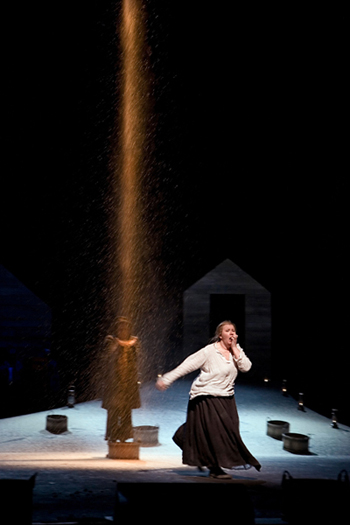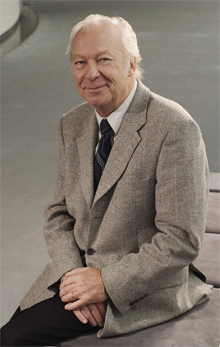 |
Topi, a crofter: Jorma Hynninen Riika, his wife: Päivi Nisula their children: Sake: Henri Schröter Raakeli: Sanni Vilmi Iita-Linta Maria: Judit Kyyhkynen Puntarpää, the agitator: Aki Alamikkotervo Simana Arhippaini: Hannu Forsberg Vicar: Pertti Mäkelä Young priest: Tuomas Tuloisela Raappana, the cobbler: Ilkka Hämäläinen Kunilla, his wife: Irene Parkkinen Kaisa: Sari Nordqvist Epra: Olavi Suominen Jussi: Veli-Pekka Väisänen Tiina: Leena Liimatainen Constable Pirhonen: Kai Valtonen
Director: Pekka Milonoff Sets: Eeva Ijäs Costumes: Erika Turunen Lighting design: Juha Westman Choreographer: Ari Numminen Commissioned by the Finnish National Opera World premiere November 30,1978 Premiere March 16, 2007 | ||
Revisiting The Red Line
I was asked whether Kianto's one-century-old novel and this thirty-year-old opera had anything relevant to say to our age any more. It is, in fact, the fervent hope of a humanist that the core of this story should be outdated, a thing of the past.
But the humanist is disappointed. The work remains just as topical as ever. It gives hope to the "little" people as they try to influence the quality and course of their lives, but it also questions the reality of this possibility.
"Am I a pessimist?" I am asked. "No," I say, "I am a realist." Sometimes an optimistic realist. Of course, the first parliamentary election in Finland, the drawing of the red line, was an important step on the road to a fairer and more just society. So we think at times at least when we still have the energy for faith in the human species, and even when our trust in the rationality of that species is being sorely tested.
Free elections, self-evident here, are anything but self-evident in many places in the world today. Therefore some democratic nations have taken on a missionary stance: this social order is an absolute value which must be enforced everywhere, at gunpoint if necessary. History will show whether this was the right thing to do. But here and now we have to live with it, as no one has yet come up with a better system than democracy.
One of the main themes of the opera is the manipulation of human minds. There are several spheres of power involved, vying for control over the souls of men. There is the strict and merciless Lutheran God of the Vicar; there is Kaisa's God, who is a mixture of the old faith and of pantheism; there is the Orthodox God of Simana Arhippainen, into which the bearded figure of the Tsar is amalgamated; and there is the socialist doctrine of Puntarpää, the agitator, which was hailed as a force that would sweep away the old system.
Puntarpää epitomises the political and religious firebrand preachers who can be found at all times and in all cultures. The little people are ground to a pulp under the weight of such ideologies. Where can a poor body find the freedom and strength to choose between them? Art - musical theatre in this case - cannot provide answers. But it is good if it can at least raise questions.
Aulis Sallinen
February 2007
 |
Aulis Sallinen Six operas, eight symphonies, concerti, chamber music, songs, premieres abroad and prizes...Aulis Sallinen's highly successful career has now lasted over forty years. Internationally he is the most successful Finnish composer, particularly in the genre of opera. Sallinen's first two operas, Ratsumies and Punainen viiva (The Red Line) inaugurated a wave of opera enthusiasm in Finland, and the new operas even became popular with the public at large. Aulis Sallinen was already an established composer when he won the Savonlinna Opera Festival composition competition with Ratsumies, premiered in 1975. Although he had mostly written instrumental music until then, his first opera proved to be a mature work in the genre. Sallinen's next opera was Punainen viiva (1978). Depicting the life of poor people and the first general election in Finland in the early 20th century, it was more 'folk-like' than Ratsumies. Sallinen's international reputation began to grow with performances of the opera abroad on foreign tours of the Finnish National Opera. Among others compositions of Sallinen – operas lдhtee Ranskaan (The King Goes Forth to France), Kullervo, Palatsi (The Palace) and King Lear. |
